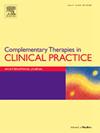Associations of physical activity, screen time, sleep duration with optimal eating habits among adolescents
IF 2.2
3区 医学
Q2 INTEGRATIVE & COMPLEMENTARY MEDICINE
引用次数: 0
Abstract
Objective
The aim of this study was to explore the associations of physical activity, screen time and sleep duration with various eating habits among children.
Methods
The data were collected from six surveys of the Youth Risk Behaviour Survey conducted in 2011, 2013, 2015, 2017, 2019, and 2021, with a total of 78, 697 participants with complete information. Information on demographic characteristics (e.g., sex, age), physical activity, screen time, sleep duration, and eating habits was collected via a self-reported questionnaire. A series of logistic regressions were used to assess the association between independents and outcomes. Results were presented as odds ratio (OR) with 95 % confidence interval (CI).
Results
A dose-response relationship was observed between the number of guidelines (i.e., physical activity, screen time, sleep) achieved by adolescents and improved eating habits compared to those not meeting any guidelines. For example, meeting any one (OR = 1.28, 95 % CI = 1.17–1.41), any two (OR = 1.47, 95 % CI = 1.33–1.62), and all three (OR = 2.13, 95 % CI = 1.73–2.61) guidelines were associated with more fruit consumption. Moreover, meeting all three guidelines was associated with a higher likelihood of meeting guidelines for fruit juice (OR = 1.41, 95 % CI = 1.23–1.60), fruit (OR = 2.13, 95 % CI = 1.74–2.62), other vegetables (OR = 1.56, 95 % CI = 1.33–1.84), milk (OR = 1.46, 95 % CI = 1.28–1.66), breakfast (OR = 2.80, 95 % CI = 2.41–3.25), and soda or pop (OR = 1.16, 95 % CI = 1.04–1.30) compared to not meeting any guidelines.
Conclusions
Findings from this population-based study indicate that meeting the combination of physical activity, screen time, sleep guidelines is associated with better eating habits. Notably, meeting the physical activity guidelines or its combination shows the strongest associations with favourable dietary habits among adolescents. Future research should further explore effective strategies to promote entire 24-h movement behaviours, especially physical activity, which can be useful to optimize eating habits in adolescents.
青少年身体活动、屏幕时间、睡眠时间与最佳饮食习惯的关系
目的探讨儿童体育活动、屏幕时间和睡眠时间与不同饮食习惯的关系。方法收集2011年、2013年、2015年、2017年、2019年和2021年《青少年危险行为调查》6次调查的数据,共计78,697名信息完整的参与者。通过自我报告问卷收集了人口统计学特征(如性别、年龄)、身体活动、屏幕时间、睡眠时间和饮食习惯等信息。使用一系列逻辑回归来评估独立患者与结果之间的关联。结果以95%置信区间(CI)的优势比(OR)表示。结果与未达到任何指导方针的青少年相比,青少年达到的指导方针(即体力活动、屏幕时间、睡眠)的数量与改善的饮食习惯之间存在剂量-反应关系。例如,满足任何一项(OR = 1.28, 95% CI = 1.17-1.41)、任何两项(OR = 1.47, 95% CI = 1.33-1.62)和所有三项(OR = 2.13, 95% CI = 1.73-2.61)指南都与食用更多水果有关。此外,与不符合任何指南相比,符合所有三项指南与符合以下指南的可能性更高相关:果汁(OR = 1.41, 95% CI = 1.23-1.60)、水果(OR = 2.13, 95% CI = 1.74-2.62)、其他蔬菜(OR = 1.56, 95% CI = 1.33-1.84)、牛奶(OR = 1.46, 95% CI = 1.28-1.66)、早餐(OR = 2.80, 95% CI = 2.41-3.25)、苏打水或汽水(OR = 1.16, 95% CI = 1.01 - 1.30)。这项基于人群的研究结果表明,结合体育锻炼、屏幕时间和睡眠指南与更好的饮食习惯有关。值得注意的是,符合体育活动指南或两者结合表明,青少年良好的饮食习惯具有很强的相关性。未来的研究应进一步探索促进全天24小时运动行为的有效策略,特别是身体活动,这可能有助于优化青少年的饮食习惯。
本文章由计算机程序翻译,如有差异,请以英文原文为准。
求助全文
约1分钟内获得全文
求助全文
来源期刊

Complementary Therapies in Clinical Practice
INTEGRATIVE & COMPLEMENTARY MEDICINE-
CiteScore
6.30
自引率
6.70%
发文量
157
审稿时长
40 days
期刊介绍:
Complementary Therapies in Clinical Practice is an internationally refereed journal published to meet the broad ranging needs of the healthcare profession in the effective and professional integration of complementary therapies within clinical practice.
Complementary Therapies in Clinical Practice aims to provide rigorous peer reviewed papers addressing research, implementation of complementary therapies (CTs) in the clinical setting, legal and ethical concerns, evaluative accounts of therapy in practice, philosophical analysis of emergent social trends in CTs, excellence in clinical judgement, best practice, problem management, therapy information, policy development and management of change in order to promote safe and efficacious clinical practice.
Complementary Therapies in Clinical Practice welcomes and considers accounts of reflective practice.
 求助内容:
求助内容: 应助结果提醒方式:
应助结果提醒方式:


